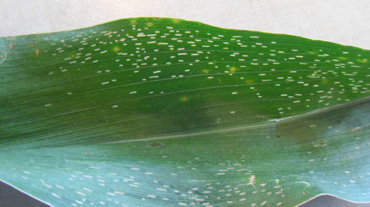Agronomists get many calls during a typical growing season when things aren’t going right in corn and soybean fields in the geographies that we cover. Most of the time, problems are caused by common diseases or insects. Sometimes, though, we receive calls about damage to plants that is caused by uncommon pests.
One of these “uncommon pests” that has become more common over the last ten years is the corn blotch leafminer (CBL). This pest has caused minor damage to fields for as long as corn has been grown. However, with changes in average weather conditions or possibly due to insecticide management changes, it seems that the prevalence of this insect has increased.
Corn blotch leafminers are identified as a brown fly approximately 1/4″ long. During the spring, CBL adults begin to feed on corn leaves and place eggs in the upper or lower surface of the lower leaves on the corn plant. Once the eggs hatch, the larvae (maggots) tunnel into the center of the leaf. The maggots damage the leaves by tunneling into the leaf and “mining” out the leaf’s interior. Because each female can lay up to 100 eggs, numerous tunnels can often be found in some leaves.
The life cycle of CBL ranges in length from four to six weeks, which means there can be three to five generations of CBL per growing season. The maggots pupate inside the leaf’s mined-out area and emerge as adults approximately two weeks after pupation. Later in the season, fully developed larvae or pupated larvae within corn residue will fall to the soil where they will overwinter.
Due to the low number of leaves affected, and the relatively small amount of leaf area damaged, the losses caused by CBL are usually considered a non-issue. That is a good thing because our ability to control this pest is limited. The adults emerge over a long period, so insecticide control can be difficult. Also, the maggots are well protected within the leaf as they tunnel, making it very difficult to control them.
~ Scott Dickey, M.S., CCA – Field Agronomist

